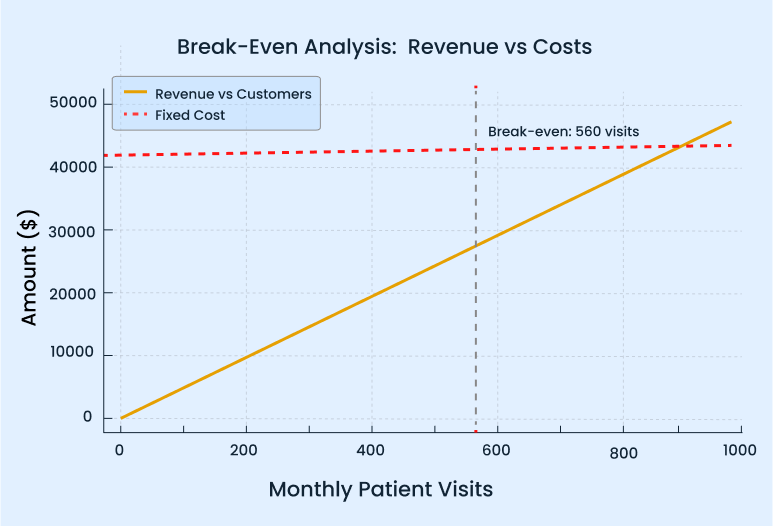Executive Summary
Align & Thrive Chiropractic is a new clinic in the Short North Arts District of Columbus, Ohio. It is set up as a limited liability company (LLC). The clinic will offer chiropractic care, posture scans, massage, and nutrition support. The location is central, the community is diverse, and demand for non-surgical pain relief is high. This makes it a strong fit for the practice.
Problem We Solve
In Columbus, nearly 1 in 4 adults report chronic back pain, and many also deal with posture problems and sports injuries that affect daily life. Nationally, the 2023 CDC Data Brief No. 518 shows that 24.3% of U.S. adults had chronic pain in the past 3 months, showing this is a widespread issue.
Current clinics often fall into two extremes: Large insurance-heavy practices with long waits or boutique offices that are costly and limited in scope. Patients need a middle option that is fast, affordable, and focused on ongoing wellness.
Most local clinics do not offer:
- Bilingual staff for English and Spanish-speaking patients, leaving a gap in accessibility.
- Digital posture assessments using tools like PostureScreen™ provide measurable data for care plans.
- Membership-based care models that encourage long-term wellness instead of one-time visits.
Align & Thrive is built to fill this gap. The clinic provides same-day appointments, posture scans, decompression therapy, massage, and nutrition support. Membership plans ensure care stays consistent, affordable, and focused on long-term results rather than quick fixes.
Key to Success
The clinic’s success depends on strong clinical skills, a good location, and trusted service. Dr. Amanda Collins has ten years of experience and close ties to the community as a former Ohio State athlete. The Short North Arts District location brings steady foot traffic from students, young professionals, and retirees.
Key advantages include:
- Digital scans that track progress
- Same-day visits for busy patients
- Bilingual staff for Hispanic patients
- Bundled services that improve loyalty and revenue
Financial Outlook
Startup costs are $420,000. This includes a $325,000 loan from PNC Bank and $95,000 in owner equity. The clinic expects to break even in 12–15 months with about 560 monthly visits, including memberships. Revenue should grow from $480,000 in Year 1 to $1.2 million in Year 3. Net margins will rise from –2% in Year 1 to 15% by Year 3, helped by steady membership growth and controlled costs.

| Year | Revenue | Gross Margin ($) | Gross Margin % | Net Margin % | Net Income |
|---|---|---|---|---|---|
| 1 | $480,000 | $250,000 | 52% | -2% | -$10,000 |
| 2 | $840,000 | $470,000 | 56% | 9% | $75,000 |
| 3 | $1,200,000 | $744,000 | 62% | 15% | $180,000 |

Not sure how to draft a chiropractic business plan?
Get Upmetrics’ free chiropractic business plan template to quickly structure your ideas and build a professional plan with step-by-step guidance.
- Easy-to-follow structure
- Built-in financial projections
Company Overview
Align & Thrive Chiropractic is a licensed clinic in Ohio, formed as an LLC in March 2026. It also holds a state chiropractic license and has radiation safety certification for its digital X-ray system.
Mission
Our goal is to provide safe, proven chiropractic care that helps people recover from pain, improve posture, and stay healthy long-term. We focus on making care accessible with bilingual staff, same-day visits, and affordable wellness plans.
Vision
We aim to be Columbus’s top wellness hub. Patients will come not only for pain relief, but also for lasting support in building healthy habits and active lifestyles.
Ownership and Management
| Owner | Equity % | Role | Background |
|---|---|---|---|
| Dr. Amanda Collins, DC | 80% | CEO & Lead Chiropractor | Chiropractor, 10 years’ experience. |
| Eric Daniels, MBA | 20% | COO | Healthcare operations manager. |
History / Background
Align & Thrive Chiropractic was founded by Dr. Amanda Collins. As a student-athlete at Ohio State, she had a back injury that almost ended her soccer career. Chiropractic care helped her heal. It also gave her the push to make this her career. She later studied at Palmer College and has practiced in Ohio for ten years. During this time, she gained recognition for assisting athletes, families, and seniors with pain and posture management.
Dr. Collins partnered with Eric Daniels to bring her vision to life. He has strong skills in business and healthcare operations. Together, they planned a clinic in Columbus’s Short North area. The location was chosen with care. It has many young professionals, students, and retirees. These groups form the main patient base the clinic wants to serve.
Identity & Brand
The name shows the mission clearly. “Align” means safe chiropractic care that fixes posture and reduces pain. “Thrive” means long-term health and wellness for patients. The clinic supports this goal with massage, nutrition, and lifestyle coaching. The brand is built on trust, simple access, and proven care. With bilingual support, Align & Thrive is more than just adjustments. It is a partner in health for the whole community.
Objectives
- Year 1: Reach ~225 active patients, ~325 monthly visits, and secure one corporate wellness contract.
- Year 2: Achieve break-even by Month 18 with ~480 monthly visits and 40–50% membership adoption.
- Year 3: Grow to ~400 patients, ~560 visits/month, and generate ~$1.2M in revenue with ~15% net margin.
- Long-term: Expand to a second Columbus location once the first is profitable and stable.
Need help writing your business plan?
Upmetrics AI lets you create a professional plan in minutes.
Plans starting from $14/month

Industry and Market Analysis
Overview
Franklin County has a population of 1,334,729, with steady annual growth of about 0.33%. The Short North Arts District sits at the center of this county and attracts young professionals, Ohio State University students, and retirees—three groups that drive strong demand for chiropractic and wellness services. Back pain alone affects close to 30% of adults, which equals nearly 390,000 Franklin County residents each year, creating a large treatment pool.

In 2024, the global chiropractic market stood at $20.0 billion. It should grow to $28.6 billion by 2035, moving at about 3.3% growth per year. The numbers point to steady demand as people keep finding value in chiropractic care.

Key Demand Drivers
- Ohio State’s 61,000 students and athletic programs feed ongoing demand for posture and injury care.
- A retiree population of 13% drives needs around arthritis, disc issues, and mobility.
- The median household income of $72,800 in the area supports private-pay care.
Target Market Snapshot
| Segment | Main Needs | How Align & Thrive Fits |
|---|---|---|
| Young Professionals (25–40) | Desk-related posture pain | Posture scans, bundled care |
| OSU Athletes & Fitness Enthusiasts | Acute/repetitive injuries | Same-day adjustments, recovery plans |
| Retirees (65+) | Chronic pain, mobility | Decompression therapy, senior wellness plans |
| Corporate Partners | Reduce staff claims, wellness | On-site screenings, memberships |
Market Economics
Patients will spend an average of $250/month when enrolled in bundled services. Core price points include:
- $110 – first consultation with posture scan
- $65 – adjustment session
- $95 – one-hour massage
- $500/month – wellness package (4 adjustments, 2 massages, 1 posture scan)
At standard visit rates alone, break-even would require ~1,080 visits/month. With bundled memberships blended in, the effective break-even drops to ≈560 visits/month (~28 per day).
Competitive Positioning
| Clinic | Market Position | Gap in Service |
|---|---|---|
| Short North Chiropractic | Insurance-driven, established | No posture scans, limited wellness add-ons |
| True Wellness Chiropractic | Boutique, upscale care | Higher pricing, no bilingual staff |
| Easton Chiropractic Center | Large rehab facility | Location outside core, long wait times |
Align & Thrive’s Edge
The clinic aims to bridge the gap with:
- Digital posture scans for measurable results
- Same-day scheduling for acute cases
- Bilingual staff (English/Spanish) to serve an underserved population
- Wellness bundles that keep patients engaged and improve retention
Services
Clinical Services
Align & Thrive will provide a mix of core and add-on treatments designed to address pain, posture issues, and long-term wellness.
| Service | Description | Price | Role in Revenue |
|---|---|---|---|
| New Patient Consultation & Posture Scan | Case history, orthopedic/neurological exam, digital posture scan (PostureScreen™) | $110 | Differentiator: builds treatment plan and credibility |
| Chiropractic Adjustments | Manual and instrument-assisted adjustments for back, neck, and headache relief | $65/session | Core service; ~50% of Year 1 revenue |
| Spinal Decompression Therapy | Non-surgical traction for herniations, sciatica, and degenerative disc issues | $85/session | High-margin; alternative to surgery |
| Massage Therapy | 30/60/90-minute sessions with licensed therapists | $95/hr | Attracts wellness clients, expands base |
| Nutritional & Lifestyle Coaching | Counseling on diet, supplements, ergonomics, and posture habits | $75/session | Adds 5–7% of revenue; boosts wellness branding |
Membership & Packages
Plans help patients stay on track and improve results. Bundles give steady revenue and more value.
- Monthly Wellness Plan ($150–$170/month): 4 adjustments, 2 massages, posture scan, and lifestyle coaching.
- Core Relief Plan ($250/month): 8 adjustments, 2 decompression sessions, and priority scheduling.
- Short-Term Package ($600/12 visits): For patients needing care in 8 weeks.
Seasonal Offerings
These limited-time offers run apart from memberships and are designed to bring in new patients.
- Back-to-School Tune-Up: $29 posture scans (Sept–Oct).
- Winter Wellness Package: $199 for 3 adjustments + 1 massage (Dec–Feb).
- Corporate Screenings: Free posture scans at offices with discount vouchers for follow-ups.
Pricing Strategy
Prices are set mid-range. They are higher than insurance-only clinics but lower than boutique providers. Insurance billing is accepted with Anthem, Aetna, Cigna, and UnitedHealthcare. These visits are expected to be about half of the patient volume. The other half will come from private-pay memberships, which bring faster payments and higher margins. Discounts will be used only for seasonal promotions.
Patient Journey Example
A 30-year-old OSU staff member comes in with acute back pain. They pay $110 for the initial consult and posture scan, then join the Athlete Recovery Plan ($350/month). Over 10 months, this patient generates ~$3,500 in revenue versus ~$650 if they had only booked individual adjustments.
By blending core clinical services with bundled memberships, Align & Thrive shifts its model from one-time visits to recurring, predictable revenue. This structure strengthens patient loyalty, improves cash flow, and supports stable loan repayment.
Wondering how to draft your plan?
Use our AI business plan generator to prepare a solid plan.
Plans starting from $14/month

Marketing & Sales Strategy
Strategic Objective
Align & Thrive’s goal is to become the most recognized chiropractic and wellness clinic in Columbus’s Short North district. The plan focuses on three growth levers: Digital visibility, community presence, and workplace wellness. By combining these, the clinic aims to reach 250 active patients in Year 1 and expand to 400+ by Year 3, with at least half on recurring membership plans.
Channel Approach
Instead of spreading spend thin, marketing dollars are concentrated where they convert fastest.
- Digital Presence (40% of spend): Google Ads targeting keywords like “Columbus chiropractor” and “sports injury chiropractor” plus SEO and paid social campaigns. Instagram and Facebook will target OSU students and young professionals, while TikTok videos demonstrate posture scans and decompression therapy.
- Community & Bilingual Outreach (25%): The clinic will use Spanish-language radio ads on La Mega 103.1 FM and share bilingual brochures in local shops. Free posture scan events will run at gyms, and the team will sponsor the Short North Health Fair.
- Physician & PT Referrals (20%): The clinic will work with physical therapists and doctors to build a referral pipeline. Patient outcome reports will be shared, and bonuses will be offered for repeat referrals.
- Corporate Wellness (15%): The clinic will partner with local employers, such as tech startups and creative agencies. On-site posture screenings and subsidized memberships will be offered.
Channel Budget Overview
| Channel | Monthly Spend | Share of Budget |
|---|---|---|
| Digital Ads & SEO | $3,300 | 40% |
| Community Outreach | $2,000 | 25% |
| Physician/PT Referrals | $1,600 | 20% |
| Corporate Wellness | $1,200 | 15% |
| Total | $8,300 | 100% |
Promotional Offers
To accelerate patient acquisition, Align & Thrive will run targeted promotions: A grand opening special ($29 consultation + adjustment for the first 100 patients), a referral credit ($25 for both referrer and new client), student discounts (20% for OSU IDs), and a package launch discount (15% off the first month).
Conversion & Retention
The sales model is built on package conversion. Around 40% of first-time patients are expected to commit to a membership within two visits. Members typically stay 9–12 months, creating predictable recurring revenue. Quarterly posture scan reviews provide tangible progress updates that keep patients motivated and engaged.
Operations Plan
Clinic Hours & Access
Align & Thrive will run extended hours to meet patient demand. The clinic will operate Monday–Friday, 8:00 AM – 7:00 PM, and Saturday, 9:00 AM – 2:00 PM. Same-day and next-day appointments will be available through the online booking portal. A small number of slots are reserved daily for emergency walk-ins, particularly sports injuries and acute pain cases.
Facility & Layout
The 2,000 sq. ft. facility at 867 N High Street is designed for efficiency and compliance with ADA and Ohio Board of Chiropractic standards. Key spaces include:
- Reception and waiting area with seating for 12, digital check-in kiosk, and bilingual signage
- Two adjustment rooms with Hill Labs flexion/distraction tables
- One massage therapy room, soundproofed for privacy
- A digital X-ray suite equipped with a RadmediX DR system and radiation shielding
- A wellness office for nutritional coaching and posture consultations
Staffing Plan (Year 1)
The clinic will start with a lean but balanced team to manage patient demand and support daily operations. The table below outlines each role, headcount, and key responsibilities.
| Role | Headcount | Key Responsibilities |
|---|---|---|
| Lead Chiropractor (Dr. Amanda Collins) | 1 | Clinical oversight, adjustments, and patient care plans |
| Associate Chiropractor | 1 | Manage additional patient load, handle walk-ins, and insurance billing |
| Licensed Massage Therapists | 2 | Deliver 30–40 massage hours per week combined |
| Nutritionist (PT contractor) | 1 | Provide nutritional and lifestyle consultations, support wellness packages |
| Office Manager (Eric Daniels) | 1 | Oversee finance, payroll, vendor contracts, and compliance reporting |
| Receptionists | 2 | Handle scheduling, insurance verification, intake, and bilingual support |
This balances lean operations with the ability to handle ~28 daily visits, the break-even volume.
Vendors & Suppliers
Key partnerships ensure reliable, high-quality equipment and consumables:
- Hill Labs – chiropractic tables
- RadmediX – digital X-ray system (FDA-approved)
- Earthlite – massage tables and accessories
- Cardinal Health – medical consumables such as gloves and sanitizers
- Office Depot Commercial – front-office supplies and check-in kiosk
Compliance & Licensing
The clinic will operate under strict regulatory standards. Dr. Collins maintains an active Ohio chiropractic license, renewed biennially. The X-ray suite will meet radiation safety certification requirements from the Ohio Department of Health. HIPAA compliance will be enforced through encrypted electronic health record (EHR) systems and patient portals. Insurance credentialing is underway with Anthem, Aetna, Cigna, and UnitedHealthcare to ensure network coverage at launch.
Workflow in Practice
Operations will follow a simple daily routine:
- Morning huddle (7:45 AM): Staff check schedule and insurance approvals.
- Patient intake (8:00 AM): Receptionist checks insurance and does posture scans for new patients.
- Treatment: Chiropractors give adjustments and decompression, while massage sessions run at the same time.
- Scheduling: Patients book next visits before leaving; packages are offered when useful.
- Close-out: Office manager checks payments and submits insurance claims online.
Performance Metrics
Success will be measured with clear goals:
- Patient volume: ~560 visits per month by Q3 2027.
- Same-day appointment fill rate: ≥85%.
- Retention: ≥65% of new patients join membership packages.
- Billing efficiency: 95% of claims finished within 48 hours.
- Staff utilization: chiropractors ≥85% booked weekly.
Management Team
This staffing and operations model is lean but stable, letting the clinic meet demand while keeping quality, compliance, and patient care high. Our team blends clinical skill and business know-how to give patients safe, efficient, and reliable service.
| Role / Owner | Headcount | Compensation | Key Responsibilities |
|---|---|---|---|
| Dr. Amanda Collins, DC — CEO & Lead Chiropractor (80% Ownership) | 1 | Equity + clinical salary | Oversees patient care, clinic operations, and staff training. |
| Eric Daniels, MBA — Chief Operating Officer (20% Ownership) | 1 | Equity + operational salary | Manages finances, payroll, vendors, marketing, and compliance. |
| Front Desk / Admin Staff | 2 FTE | $40,000–$45,000/year | Handles appointments, check-ins, and office tasks. |
| Chiropractic Assistants | 2 FTE | $20–$25/hour | Supports patient care, therapy setup, and follow-ups. |
| Massage / Rehab Therapists | 1–2 FTE | $30–$35/hour | Provides therapy and rehabilitation services. |
Team Philosophy & Growth
Dr. Collins focuses on patient-first care, while Eric Daniels ensures smooth operations and financial health. The team will grow with more assistants and therapists as the clinic expands. CPA, legal, and insurance partners support finances, compliance, and risk management.
Financial Plan
The financial plan presents the projected startup costs, funding sources, revenue forecasts, expenses, and profitability metrics, offering a clear overview of the business’s financial outlook and sustainability
Startup Costs & Capitalization
The total projected startup capitalization is $520,000, funded through a combination of owner equity, a bank loan, and a dedicated reserve:
| Source | Amount (USD) | Notes |
|---|---|---|
| PNC Bank Loan | $325,000 | 7-year term, 8% fixed interest |
| Owner Equity | $95,000 | Already secured in business account |
| Working Capital Reserve | $100,000 | Allocated to cover payroll, AR delays, contingency |
| Total Capitalization | $520,000 | Loan + Equity + Reserve |
Breakdown of Startup Costs
| Category | Amount (USD) | Notes |
|---|---|---|
| Leasehold Improvements | $90,000 | Clinic buildout: walls, flooring, ADA restroom, signage |
| Equipment Purchases | $155,000 | Digital X-ray system and 2 adjustment tables |
| Furniture & Supplies | $20,000 | Massage table, front-desk furniture, waiting area, consumables |
| Marketing Launch | $35,000 | Initial 4-month campaign (Google Ads, radio, local events) |
| Insurance & Licenses | $25,000 | Malpractice, liability, HIPAA software, license fees |
| Payroll Reserve | $50,000 | Covers first 90 days of salaries and benefits |
| Working Capital (Ongoing) | $45,000 | Utilities, software, vendor deposits, contingency buffer |
| Additional Working Capital Reserve | $100,000 | 4–5 months of fixed costs to cover AR delays & ramp-up |
| Total Startup & Reserve | $520,000 | Loan + Equity + Reserve |
Revenue Projections
Revenue forecasts are based on patient volume growth and average monthly spend, with a targeted gross margin of 65%:
| Year | Revenue ($) | Gross Margin ($) | Gross Margin % | Operating Expenses ($) | Net Income ($) | Net Margin % |
|---|---|---|---|---|---|---|
| Year 1 | $480,000 | $250,000 | 52% | $260,000 | -$10,000 | -2% |
| Year 2 | $840,000 | $495,000 | 55% | $400,000 | $95,000 | 11% |
| Year 3 | $1,200,000 | $744,000 | 62% | $564,000 | $180,000 | 15% |
Patient Volume Assumptions
| Year | Active Patients | Avg. Monthly Visits | Avg. Patient Spend |
|---|---|---|---|
| Year 1 | ~200–225 | ~325 | $250/month (bundles) or $65–$95 per visit |
| Year 2 | ~300–325 | ~480 | $250/month (bundles) |
| Year 3 | ~375–400 | ~560 | $250/month (bundles) |
Break-Even Analysis
| Metric | Value |
|---|---|
| Fixed Monthly Costs | ~$42,000 (payroll, rent, marketing, insurance, utilities) |
| Gross Margin | 52% in Year 1 → 62% by Year 3 (conservative industry benchmark) |
| Break-even Patient Volume | The clinic’s fixed costs are about $42,000 each month. At $65 per visit, break-even needs about 1,080 visits per month (≈54/day). With memberships included, the effective break-even is about 560 visits per month (≈28/day), which is more realistic. |
| Expected Timeline | ~Month 18 (mid-Year 2), once memberships and referral contracts stabilize |

Cash Flow Summary (Year 1)
| Month | Revenue ($) | Operating Expenses ($) | Net Cash Flow ($) |
|---|---|---|---|
| Jan | 25,000 | 42,000 | -17,000 |
| Feb | 30,000 | 42,000 | -12,000 |
| Mar | 35,000 | 42,000 | -7,000 |
| Apr | 38,000 | 42,000 | -4,000 |
| May | 40,000 | 42,000 | -2,000 |
| Jun | 42,000 | 42,000 | 0 |
| Jul | 44,000 | 43,000 | +1,000 |
| Aug | 45,000 | 43,000 | +2,000 |
| Sep | 47,000 | 43,000 | +4,000 |
| Oct | 48,000 | 43,000 | +5,000 |
| Nov | 50,000 | 43,000 | +7,000 |
| Dec | 56,000 | 44,000 | +12,000 |
| Total | 500,000 | 511,000 | -11,000 |
Loan Repayment & Debt Service Coverage Ratio (DSCR)
| Year | Revenue | EBITDA* | Debt Service | DSCR |
|---|---|---|---|---|
| 1 | $480,000 | $180,000 | $65,000 | 2.8x |
| 2 | $840,000 | $300,000 | $65,000 | 4.6x |
| 3 | $1,200,000 | $500,000 | $65,000 | 7.7x |
Balance Sheet Snapshot (End of Year 1)
| Category | Amount (USD) |
|---|---|
| Assets | |
| Cash | $85,000 |
| Accounts Receivable | $40,000 |
| Total Current Assets | $125,000 |
| Equipment | $120,000 |
| Leasehold Improvements | $110,000 |
| Total Non-Current Assets | $230,000 |
| Total Assets | $355,000 |
| Liabilities | |
| Accounts Payable | $15,000 |
| Total Current Liabilities | $15,000 |
| Loan Balance | $245,000 |
| Total Long-Term Liabilities | $245,000 |
| Total Liabilities | $260,000 |
| Equity | |
| Equity Injection | $65,000 |
| Retained Earnings | $30,000 |
| Total Equity | $95,000 |
| Total Liabilities + Equity | $355,000 |
Sensitivity Analysis
| Scenario | Revenue (Y1) | Net Margin | DSCR |
|---|---|---|---|
| Base Case | $480,000 | -2% (≈ -$10k) | 0.0x (reserve-supported) |
| Best Case (+20%) | $576,000 | ~10% (≈ $60k) | 1.5x |
| Downside (-25%) | $360,000 | -20% (≈ -$90k) | <0 (requires reserve support) |
Milestones & Timeline
Align & Thrive has developed a structured phased plan to ensure operational readiness, growth, and loan repayment. Key milestones are outlined below:
Pre-Launch (Q1–Q2 2026)
- March 2026: LLC formation will be completed; chiropractic license renewal filed.
- April 2026: The Loan application will be submitted to PNC Bank.
- May 2026: Lease will be signed for 867 N High Street, Suite 202 (2,000 sq ft).
- June 2026: Architectural design and permit approvals will be finalized.
Buildout & Procurement (Q3 2026)
- July 2026: Construction will begin — ADA restroom, adjustment rooms, digital X-ray shielding.
- August 2026: Hill Labs tables and Earthlite massage tables will be delivered and set up.
- September 2026: Digital X-ray system will be installed; state radiation approval secured.
- September 2026: EHR, patient portal, and billing software will be configured.
Marketing Launch & Opening (Q4 2026)
The clinic will launch its marketing campaign in October through Google Ads, social media, and radio spots. In November, a “Free Posture Scan Day” event will be held at the OSU gym. December will mark the grand opening, with the first 100 patients offered a $29 consultation promotion.
Ramp-Up (Q1–Q3 2027)
By March 2027, Align & Thrive will have reached 150 active patients, with 30% enrolled in treatment packages. The break-even milestone is expected to be achieved in June with approximately 560 monthly visits generating $215k in revenue. September will mark the first corporate wellness partnership secured, and by December, the annual audit is projected to confirm a DSCR greater than 2.5x.
Growth & Stabilization (2028)
| Date | Milestone | Outcome |
|---|---|---|
| Mar 2028 | 300 Active Patients | 50% enrolled in recurring packages |
| Jun 2028 | New Associate Chiropractor Hired | Expanded service capacity |
| Sep 2028 | Senior Care Plan Campaign Launch | Targeted marketing for seniors |
| Dec 2028 | Annual Revenue Surpasses $1.05M | Business scaling validated |
Long-Term Expansion (2029)
Looking ahead, by March 2029, satellite clinic opportunities in Dublin or Upper Arlington will be explored. By December 2029, revenue is projected to surpass $1.35M with 400+ active patients, a net margin of ~23%, and over 40% of the loan principal will have been repaid, significantly reducing lender risk.
Want to create a plan like this for your business?
Generate your own plan in minutes using Upmetrics AI
Plans starting from $14/month

Risk & Mitigation
Every business faces risks, but Align & Thrive has clear plans to manage those tied to chiropractic care. This helps lenders see that the clinic can stay stable even if challenges arise.
Patient acquisition risk
Many chiropractic patients come through word of mouth or referrals, which can slow early growth. To reduce this, the clinic will invest in digital marketing, social media campaigns, and corporate wellness programs. Partnerships with OSU athletics and local gyms will also create referral streams beyond word of mouth.
Preference for traditional medicine
Many patients first turn to primary care doctors, pain medication, or physical therapy instead of chiropractic care, which can delay effective treatment. Align & Thrive will address this by offering free posture screenings, partnering with local primary care clinics for referrals, and running education workshops that present chiropractic as a safe and affordable option.
Insurance reimbursement delays
Payments from insurance companies can take 30–60 days. To stay stable, half of the patients will be on private-pay or membership plans. A $50,000 reserve fund and use of a professional billing service will also reduce delays and errors.
High competition
Columbus has many chiropractic clinics, which can limit growth. Align & Thrive will stand out by offering bilingual staff, same-day visits, digital posture scans, and bundled wellness services. Targeted wellness contracts with local employers will also provide a steady flow of patients competitors may not reach.
Regulatory compliance
Licensing, X-ray use, and patient privacy are closely monitored in Ohio. The clinic will use HIPAA-compliant software, complete quarterly compliance audits, and maintain $2M malpractice insurance.
Staffing and retention
It can be hard to hire bilingual staff and associate chiropractors. Align & Thrive will provide fair pay, benefits, and bonuses while also partnering with Palmer College and OSU to recruit interns and future hires.
Loan repayment and cash flow
If growth is slower than expected, the $7,200 loan payment could create stress. To manage this, the clinic has conservative break-even targets of 560 visits per month, a cash buffer, and personal guarantees from the owners for added security.
The Quickest Way to turn a Business Idea into a Business Plan
Fill-in-the-blanks and automatic financials make it easy.





